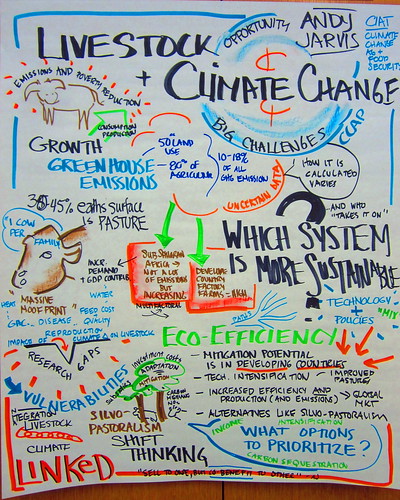Well, radical may be an overstatement, but it is worth saying that we have solutions for many things in front of us, but we have old glasses on when we need new ones. We love to protect the proverbial “elephant in the room” because after all, it is the elephant we know. But we consistently need to consider new perspectives. An “AND” perspective, not just an “OR.” This challenges status quo, power dynamics and is sometimes just hard to wrap our head around, particularly when we feel we have some “expertise” and “skin in the game” in a situation.
Last week I heard (and visually captured) CIAT’s Andy Jarvis give a great talk about the role of livestock in both feeding the world, and in green house gases. On one hand, livestock is a critical food and economic staple for the very poor, especially those who own a single cow or a few chickens. At the same time, livestock is implicated in large greenhouse gas contributions. So we have competing interests.
Or do we? There is real potential that this is not simply an “OR” proposition if we look with those new lenses. For example, Andy shared some initial data about the blending of growing trees and cows (silvo-pastoral systems) which have been growing in importance in Central and South America. New lenses. Here is a snippet:
Jarvis challenged those present at April’s meeting to look at the livestock ‘hoofprint’ as an opportunity as much as a call to immediate action. “Developing countries are where it’s at! They have the biggest potential for mitigation and major system transformations. There are systems which are far more efficient than others, and developing nations have the ability to put the rest of the world to shame.” Intensive silvo-pastoral systems, for example, were highlighted as having catalyzed a mini-revolution in Colombia and Central America due to their high CO2 capture potential and low implementation costs. According to Jarvis they are the rare climate change win-win, converting degraded pasture land into profitable, productive systems with high carbon stock, biodiversity, and resilience.
via The elephant in the room – or is it a cow? | DAPA. See also a reframe on ILRI’s blog.
Is it that simple? Certainly not. But the point is, we can’t look at greenhouse gases or food security as separate issues. They are connected. And that requires us to stretch the way we think and act. It requires a lot more “ANDs!”
This theme of AND rather than OR is popping up in my work literally every day and with every piece of work. The process challenge it offers me is to really push how I design and facilitate for, and to, AND. Yeah, that’s a messy mouthful.
This involves a) the ability to examine ideas and challenges from multiple perspectives, not just “critically from one approved perspective,” b) the ability to deal more productively with power dynamics that sit behind the influence of expertise and funding, mostly through increased transparency, and c) building our tolerance for ambiguity along the path towards action decisions. The latter is greatly enhanced by understanding when to do small “safe fail” (a la Dave Snowden) experiments, when to do larger shifts where there is a bit more certainty, and where to scale the things we really know work across different settings. I think we confuse these all the time (at least in international development, it is a challenge!)
In fact, this is not radical rethinking, folks. It is understanding how to agilely get out of our own thinking ruts, individually, organizationally and collectively. This has deep implications for our organizational structures and certainly for how we wield our power. I find it challenging (in a good way.) How about you? How are you working towards staying out of unproductive ruts?
